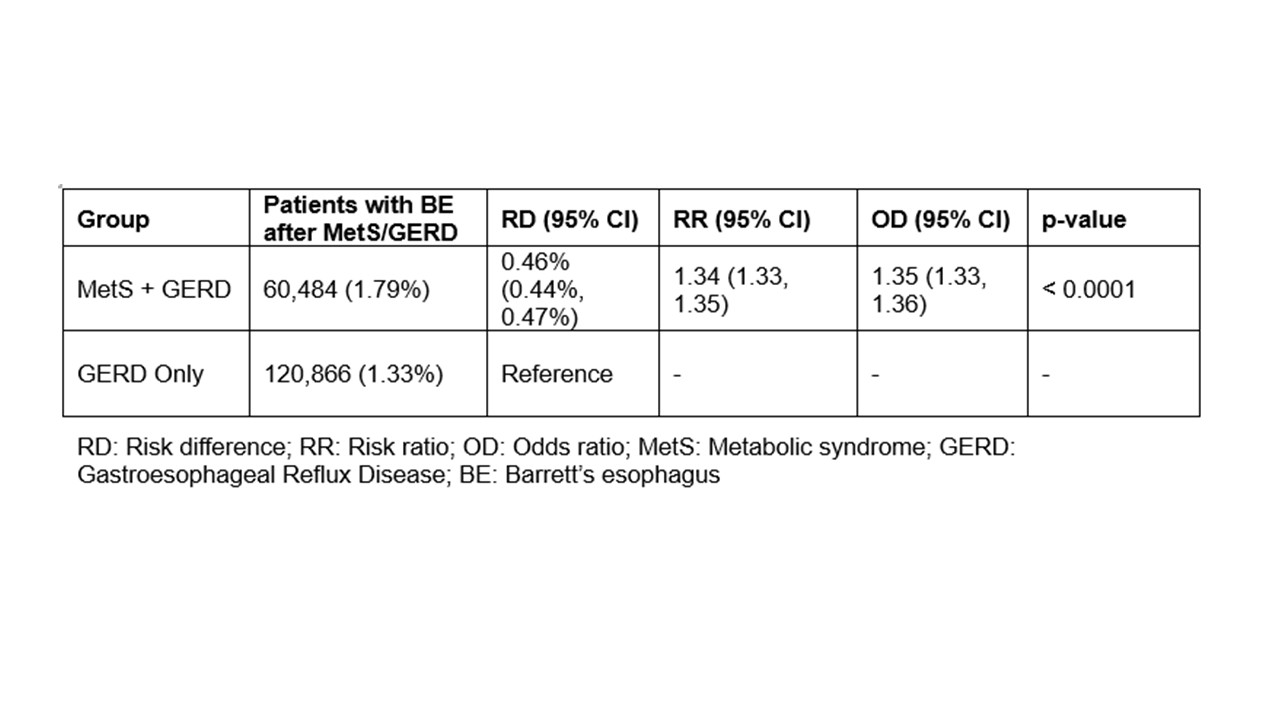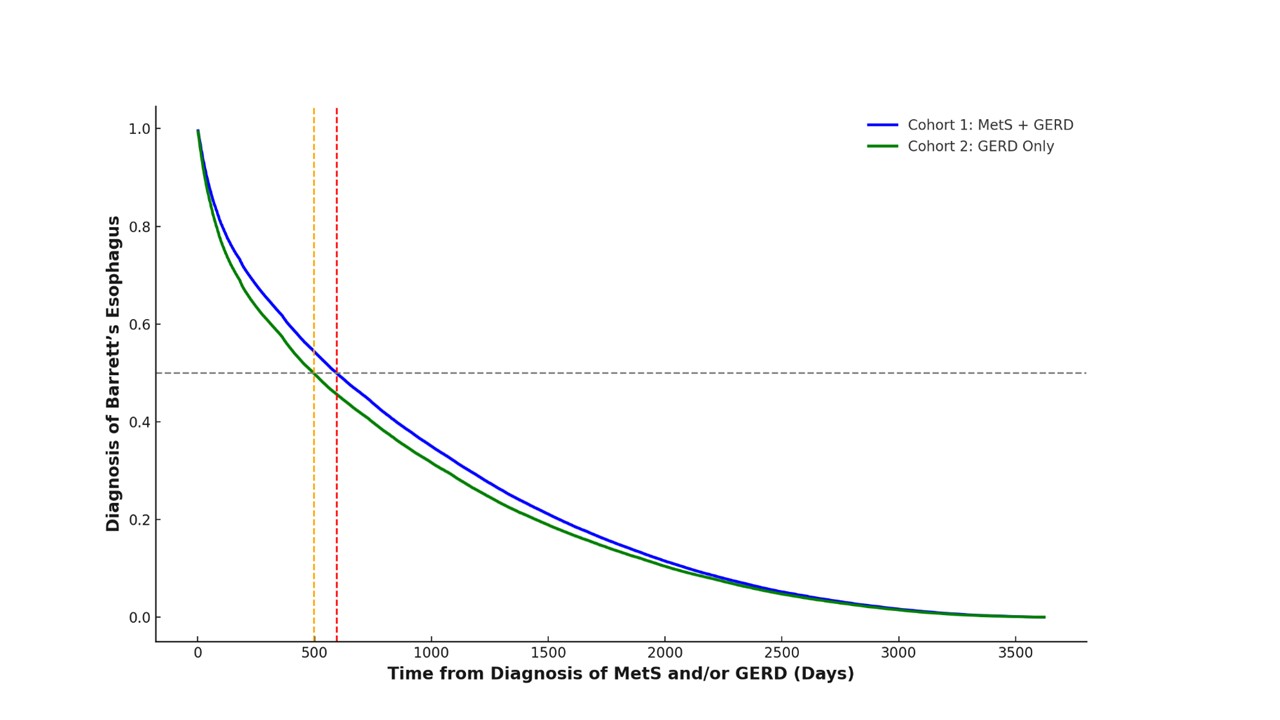Tuesday Poster Session
Category: Esophagus
P4883 - Barrett’s Esophagus Risk in Patient With Metabolic Syndrome and Gastroesophageal Reflux Disease
Tuesday, October 28, 2025
10:30 AM - 4:00 PM PDT
Location: Exhibit Hall

Julton Tomanguillo Chumbe, MD
Charleston Area Medical Center
Charleston, WV
Presenting Author(s)
Julton Tomanguillo, MD, Jennifer Collins, PhD, Anum Khakwani, MD, Nisar Amin, MD, Ebubekir Daglilar, MD, Harleen Chela, MD
Charleston Area Medical Center, Charleston, WV
Introduction: Metabolic syndrome (MetS) has emerged as a significant contributor to gastrointestinal disease, with growing evidence linking its components, particularly central obesity, to gastroesophageal reflux disease (GERD). It has been suggested that MetS may influence the development of Barrett's esophagus (BE) through additional, reflux-independent mechanisms. This study aims to examine whether patients with MetS and GERD are at an increased risk for the development of BE.
Methods: This retrospective cohort study utilized the TriNetX Analytics Platform to analyze patients aged ≥18 years between 2015-2024. Patients were stratified into two cohorts: those with MetS and GERD, and those with GERD alone. The primary outcome was the diagnosis of BE. Relative risks (RR) and 95% confidence intervals (CIs) were calculated using TriNetX’s build-in “Measures of Association” function, with statistical significance determined by p-values. Baseline characteristics were compared using t-tests and chi-square tests, with standardized mean differences (SMDs) used to assess balance. Race, sex, and smoking history were evaluated as potential confounders, but only age at index required adjustment via matching.
Results: The analysis included a total of 12,432,503 patients, with 3,378,270 having MetS and GERD, and 9,054,233 with GERD alone. Among patients diagnosed with BE, those in the MetS + GERD group were slightly older (mean current age: 70.1 ± 11.5 vs 69.8 ± 11.6, SMD = 0.0235), and more likely to have a history of smoking (14% vs. 11%), although the SMD was below the threshold for matching (SMD = 0.0865). Patients with MetS and GERD exhibited a significantly higher incidence of BE (RR: 1.34, p < 0.0001) (Table 1). Despite this, it took longer for patients with GERD and MetS to be diagnosed with BE (594 days vs 496 days) (Figure 1).
Discussion: Patients with MetS and GERD have a significantly increased risk of developing BE compared to those with GERD alone. Additionally, patients with MetS and GERD tend to take longer to be diagnosed with BE. This may be linked to the fact that patients with MetS often have other comorbidities, such as cardiovascular disease or diabetes, which may divert clinical focus away from the timely diagnosis of BE.

Figure: Table 1: Risk of Barrett’s Esophagus between Patients with Metabolic Syndrome and GERD vs GERD Alone

Figure: Figure 1: Time of EC Diagnosis between Patients with Metabolic Syndrome and GERD vs GERD Alone
Disclosures:
Julton Tomanguillo indicated no relevant financial relationships.
Jennifer Collins indicated no relevant financial relationships.
Anum Khakwani indicated no relevant financial relationships.
Nisar Amin indicated no relevant financial relationships.
Ebubekir Daglilar indicated no relevant financial relationships.
Harleen Chela indicated no relevant financial relationships.
Julton Tomanguillo, MD, Jennifer Collins, PhD, Anum Khakwani, MD, Nisar Amin, MD, Ebubekir Daglilar, MD, Harleen Chela, MD. P4883 - Barrett’s Esophagus Risk in Patient With Metabolic Syndrome and Gastroesophageal Reflux Disease, ACG 2025 Annual Scientific Meeting Abstracts. Phoenix, AZ: American College of Gastroenterology.
Charleston Area Medical Center, Charleston, WV
Introduction: Metabolic syndrome (MetS) has emerged as a significant contributor to gastrointestinal disease, with growing evidence linking its components, particularly central obesity, to gastroesophageal reflux disease (GERD). It has been suggested that MetS may influence the development of Barrett's esophagus (BE) through additional, reflux-independent mechanisms. This study aims to examine whether patients with MetS and GERD are at an increased risk for the development of BE.
Methods: This retrospective cohort study utilized the TriNetX Analytics Platform to analyze patients aged ≥18 years between 2015-2024. Patients were stratified into two cohorts: those with MetS and GERD, and those with GERD alone. The primary outcome was the diagnosis of BE. Relative risks (RR) and 95% confidence intervals (CIs) were calculated using TriNetX’s build-in “Measures of Association” function, with statistical significance determined by p-values. Baseline characteristics were compared using t-tests and chi-square tests, with standardized mean differences (SMDs) used to assess balance. Race, sex, and smoking history were evaluated as potential confounders, but only age at index required adjustment via matching.
Results: The analysis included a total of 12,432,503 patients, with 3,378,270 having MetS and GERD, and 9,054,233 with GERD alone. Among patients diagnosed with BE, those in the MetS + GERD group were slightly older (mean current age: 70.1 ± 11.5 vs 69.8 ± 11.6, SMD = 0.0235), and more likely to have a history of smoking (14% vs. 11%), although the SMD was below the threshold for matching (SMD = 0.0865). Patients with MetS and GERD exhibited a significantly higher incidence of BE (RR: 1.34, p < 0.0001) (Table 1). Despite this, it took longer for patients with GERD and MetS to be diagnosed with BE (594 days vs 496 days) (Figure 1).
Discussion: Patients with MetS and GERD have a significantly increased risk of developing BE compared to those with GERD alone. Additionally, patients with MetS and GERD tend to take longer to be diagnosed with BE. This may be linked to the fact that patients with MetS often have other comorbidities, such as cardiovascular disease or diabetes, which may divert clinical focus away from the timely diagnosis of BE.

Figure: Table 1: Risk of Barrett’s Esophagus between Patients with Metabolic Syndrome and GERD vs GERD Alone

Figure: Figure 1: Time of EC Diagnosis between Patients with Metabolic Syndrome and GERD vs GERD Alone
Disclosures:
Julton Tomanguillo indicated no relevant financial relationships.
Jennifer Collins indicated no relevant financial relationships.
Anum Khakwani indicated no relevant financial relationships.
Nisar Amin indicated no relevant financial relationships.
Ebubekir Daglilar indicated no relevant financial relationships.
Harleen Chela indicated no relevant financial relationships.
Julton Tomanguillo, MD, Jennifer Collins, PhD, Anum Khakwani, MD, Nisar Amin, MD, Ebubekir Daglilar, MD, Harleen Chela, MD. P4883 - Barrett’s Esophagus Risk in Patient With Metabolic Syndrome and Gastroesophageal Reflux Disease, ACG 2025 Annual Scientific Meeting Abstracts. Phoenix, AZ: American College of Gastroenterology.
